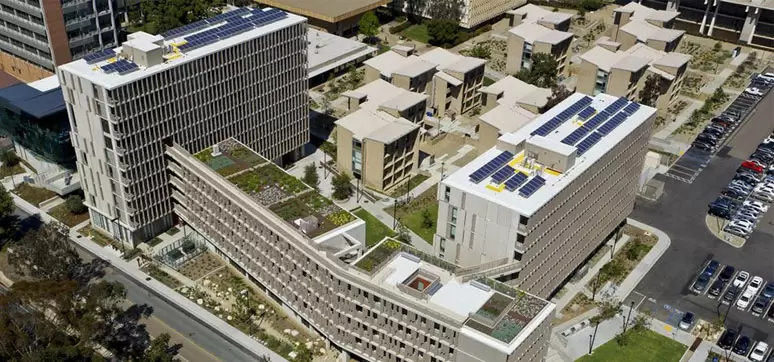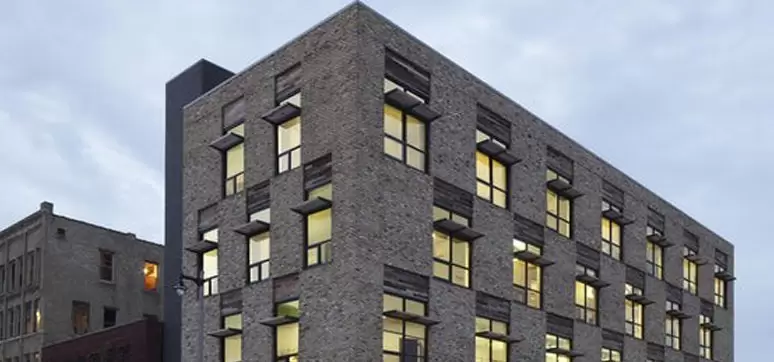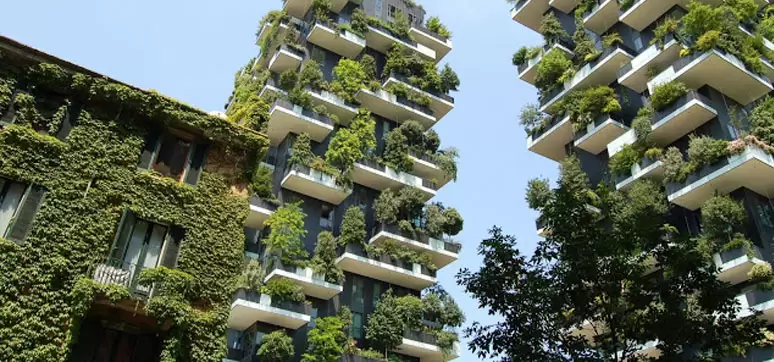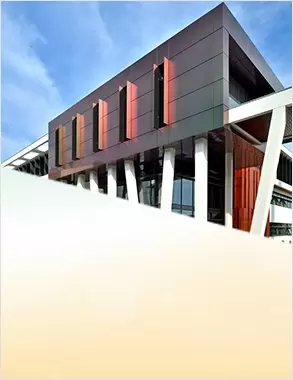What is a green building- concept, benefits, objectives and why its important in today’s business. A green building is creating a structure using those processes and methods which are responsible to the environment and are resource efficient throughout the life cycle of a building from its placement to its design, construction, operation and further to its maintenance and then on at a later stage its renovation and a full and final deconstruction. We see that this is complementary to a traditional or classic building design with concerns of economy, durability and strength as well as comfort. It is also known as a sustainable or a high performance building.
Post your Requirement

Let us explore the effects of a built environment through a short-listing table.
| Aspects: Building env. | Consumption of | Environment effects | Ultimate effects |
| -Siting
-Design -Construction -Operation -Maintenance -Renovation -Deconstruction |
-Energy
-Water -Metals -Natural Resources
|
-Waste
-Air pollution -Water pollution -Indoor pollution -Heat Islands -Storm water -Noise |
-Harm to human health
-Environmental degradation -Loss of resources |
Green buildings are designed in such a way that there is reduced effect of the built environment on human health and the natural environment. This is done by:
- Efficiently using energy, water and other resources.
- Protection of occupant`s health and improvement of employee`s productivity
- Reduction of waste, pollution and environmental degradation.
This is done by incorporating sustainable materials in the construction. (reused, recycled material made fom renewable esources.) creating healthy indoor environments with least amount of pollutants ( e.g. reduced product emissions) and/or feature landscaping that reduce use of water e.g growing native plants that need less watering to survive.

Some more on Green Buildings:
1. Take an Intelligent Perspective on Energy
- Minimum energy use in all stages of a building`s life cycle, making buildings more comfortable and less expensive to make and run. Helping the flat owners become save energy more efficiently.
- Integrating renewable and low-carbon technology to supply the energy needs of the building.
2. Protecting Water Resources
- Exploring ways to improve drinking and waste water efficiency and management, water harvesting for safe use indoors in new ways, with minimum use in building and also harvesting rain water or melting snow and recycling water.
- Looking at the impact of buildings and their surroundings on drainage and storm water and making sure these are not clogged or strained from doing their job.
3 . Minimum Waste and Maximum Reuse
- Composting wet waste
- Incineration of waste to produce electricity can also be considered like its currently done in Sweden, Japan and some other countries.
- Using more durable materials and generating less waste.
- Engaging building users in reuse and recycling.
- Every apartment block can have their own compost pits and compost the segregated wet waste and recycle or sell the dry waste and use the compost for their plants.
4. Promoting Health and Well Being
- This can be done by bringing in fresh air, through proper ventilation creating good indoor air quality and avoiding materials and chemicals that give out toxic emissions
- Allowing ample Natural light, fresh air and green spaces in the house to promote a calm and joyful environment
- Reduction in use of artificial light saving on energy bills.
- In educational, health and residential buildings designing for the ears and the eyes. Acoustics and proper noise insulation to bring about more concentration and peaceful pleasure.
- Ensuring that people are comfortable in their homes with right indoor temperature maintenance through passive design or by building effective management as well as monitoring systems.
5. Keeping the Environment Green
- Making very sure that the urban city environment also preserves nature by building on polluted land so it resuscitates or even creating new green spaces. Parks, gardens within apartment blocks, ensuring varied wildlife and better land quality- protection and enhancement.
- Making urban areas more productive e.g. bringing in farming into the cities.
6. Building Strong, Resilient and Flexible Structures
- Adapting to the changing climate, making homes safe from floods, earthquakes and fires and ensuring buildings stand the test of time, keeping all safe.
- Designing spaces which are flexible and dynamic, futuristic, avoiding the need for demolition
- Rebuilding or also renovate to prevent them from becoming obsolete.
7. Creating Links Between Community and People
- Energising local communities in planning and also in promoting positive economic and social effects.
- Distance to amenities of all sorts and transport made easy, reducing personal transport and encouraging environmental friendly options such as walking or cycling.
- Smart electricity grids that understand how to transport energy wherever its needed.
8. Consideration given to all Stages of a Building’s Life Cycle
- Lowering of environmental impacts and maximizing local and economic value over a building`s life cycle from digging to reconstruction.
- Making sure the production and transportation of materials used while building have been done using least water and energy.
Benefits of a Green Building
Green buildings bring in multiple benefits. They help in achieving many global goals such as reducing climate change, creation of sustainable and a thriving, rich community and promoting economic growth. There are three main categories of benefits: Environmental, economic and social.
Environmental Benefits Include
Effect on climate and natural environment: Avoiding negative impacts on nature by using less water, energy and natural resources, water harvesting, composting waste and other waste management, generating their own energy and enhancing biodiversity.
At a global level: Building sector has reduction of green house gas emission compared to other emitting sectors as mentioned by UNEP 2000.
By 2050 a reduction of Carbon dioxide by 84 gigatonnes could be expected according to UNEP,2016.
The building sector has a potential of energy savings by 50% or more by 2050 reducing temperature rise to only 2 degrees Centigrade.
At a Building Level
In Australia, 62% fewer green house gas emissions have been calculated vis a vis normal buildings and 51% less water required by green following industries has been noticed.
Indian Green Building Council IGBC has said that Energy savings of 40-50% and water saving of 20-30 % has been noticed with green buildings vis a vis normal ones.
Green Star certified buildings in South Africa save 30-40% on energy and carbon emissions every year and 20-30% saving of potable water compared to other buildings.
In USA 25% less energy and 11% less water is used up by green certified buildings.
Economic Benefits
Cost savings on utility bills for the tenants and house holds due to lower energy and also use of water, lowered cost of construction, higher property value for the buildings developers and sellers, increased rates of occupancy and improved job opportunities has been noticed.
At a Global Level
- Global energy savings could be Euro 280 to 410 billion euros according to the EC 2015.
- At country level: In Canada The Canada Green building industry generated $ 23.45 billion in GDP and could create 300,000 jobs in 2014.
- It was predicted that the Us would generate 3.3 million jobs in the green sector by 2018. This probably did happen.
At a Building Level
Building owners say that new or renovated green buildings command a 7% increase in asset value over traditional buildings.
Social Benefits
Positive social impact on many who work in green buildings and better health situation.
-
- Workers in green offices, well ventilated places register 101% increase in cognitive scores.
- Employees in offices with windows slept an extra 46 minutes per night.
- Proper ventilation, Better air quality indoors, low pollutants and lower CO2 concentration led to 8% improvement in performance.
Enquire Now for Windows
Green Housing in India
In Tamil Nadu, the government has planned building solar powered green houses for rural poor. Rupees 1058 crores have been allocated for this to make 60,000 houses.
Enquire Now for Solar Panels
In Maharashtra near Mumbai in Thane district, Govardhan Eco village, a community in India has built buildings with compressed stabilized Earth Blocks using rammed earth technique, cob houses ( ADOBE bicks) with traditional thatched roofs. They have received 5 star rating from GRIHA an Indian National Green Standard for buildings , a wing of the firm TERI.
Green buildings often take measures to reduce energy consumption- both during the time its being built and operating energy to provide services such as heating and power for various equipments. It has been shown that buildings made of wood will have a lower embodied energy than those made with bricks or steel.
To reduce operational energy, designers use all kinds of ways to reduce for instance air leakage through the building envelope which is the barrier between conditioned and unconditioned space in the building. They also mark out high performance windows and provide extra insulation in walls, ceilings and floors. There is another strategy used. This is called Passive solar building design. This is used in low energy homes. Designers also make sure to orient the windows and walls and fit in awnings, porches and trees to shade windows and roofs during the summer while maximizing solar gain in the winters.
Windows are placed in such a way that natural light is allowed happy access into the rooms thus creating heavy daylighting and reducing the use of artificial electric light in the daytime. Solar water heating is another healthy aspect of such buildings. Generation of solar energy, wind power, hydro and biomass energy onsite is a welcome movement within these buildings. Power generation and use is the most taxing of all things in any building. So alternative fuelling is very crucial to save the planet.
Now lets go into how water can be more efficiently used. As of now more water is being pumped out of aquifers than what is being replenished. So there is an urgent need for recycling, reusing and treating waste water to minimize and conserve what we have. For this one can design dual plumbing. That recycles water in toilet flushing or using water being used to wash the cars, for instance.. Waste water maybe minimized by using water conserving features such as ultra low flush toilets and low-flow shower heads. Bidets help in reducing use of toilet paper which jams the sewers. Treating water and heating it improves its quality and energy efficiency and also reduces the water in circulation. Using non-sewage and grey water which is all water used other than toilet flush water is vey essential. This can then be used for toilet flushing and irrigation purposes or watering your plants.
In Philadelphia’s Comcast centre, the tallest building in the city, green initiatives have been impmented in a big way. They have a central hybrid chilling water system which cools floor by floor with steam instead of water. This is a great engineering feat. In many parts of Germany geo thermal energy from inside the earth is channeled to provide central heating in many homes.
Green Material
This would include lumber from forests, renewable plant material like bamboo and straw, dimension stone, recycled stone, recycled metal and other such products which are not toxic. These are also reusable and recyclable and renewable. As for concrete, a high performance Roman self-healing concrete is available.
Many suggest using recycled industrial products, such as products released from combustion of coal, foundry sand, and debris which comes from buildings getting demolished.
Now lets mention how indoor air quality can be improved. This includes indoor air quality, thermal quality and lighting quality.
The indoor air quality can be improved by reducing VOCs or Volatile organic compounds. There are also other impurities such as microbial contaminants. For this one can use certain construction materials and interior finishing products which have zero or low VOC emissions. This will improve the air quality. These volatile gases impair health, comfort and productivity of the residents. Formaldehyde is one such toxic emission.
Another detriment to air quality is dampness or moisture accumulation. This leads to growth of fungus and other organisms and microbes. A well insulated and tightly sealed envelope will reduce moisture problems. Adequate ventilation is a must. Personal temperature and air flow control is also needed.
Solid wood products like a wooden flooring is very good and also appealing. Allegies to dust and other particulate matter is prevented. Hardwood, vinyl, linoleum tile or slate flooring is all good. This can be used instead of carpets.Wood also moderates the humidity.
Enquire Now for Wooden Flooring
One must also have an efficient manpower to manage and maintain these green buildings to keep a vigil on the maintenance of the green concept. Waste must not go to landfills. Composting bins must be installed all over.
There is more up-front cost in these buildings and low life-cycle cost. The benefits far outweigh the initial cost. These green buildings are the logical and desperate solution to our maybe dying and sad planet. So, lets make a move in the right direction and contribute to making this planet more green.

























Post A Comment